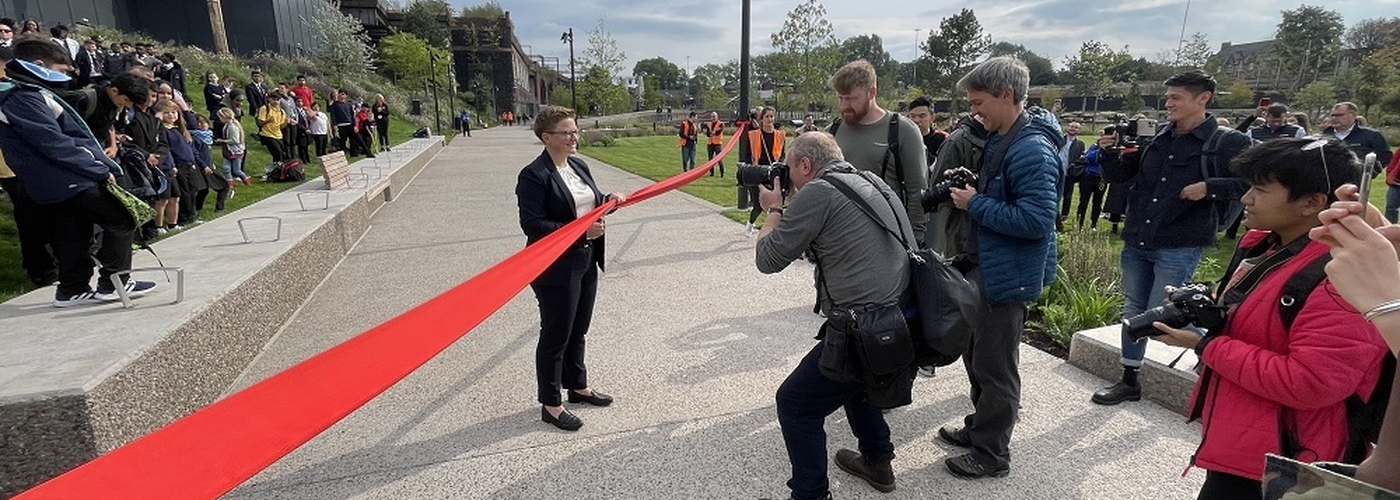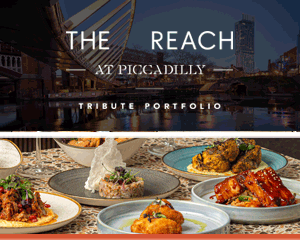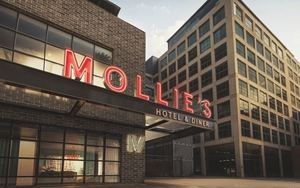Jonathan Schofield tells people to get down to Mayfield Park
Every six or seven days, perhaps even six or seven hours, actually, every six or seven minutes, many Mancunians, particularly adopted ones, complain about a lack of a proper green space in the central areas of the city.
You need to get down there. Mayfield Park is both lovely and impressive.
Two points about this.
It makes you wonder whether the complainants walk the city centre. You know, get out and about, because if they did they would find there is a surprising amount of green space either in the city centre or a short tramp away. Peel Park, Salford, for example. Much of this green space is modest in scale, Cathedral Gardens, St John’s Gardens and so on, but it still exists while the greening of the landscape surrounding the Universities along Oxford Road has been wonderful to behold in the last five years.
The second point with the green space debate is that it displays graphic historical illiteracy. Manchester’s hectic growth in the late eighteenth and early nineteenth centuries precluded the reality of a big central park. Manchester’s growth was predicated on one thing the pursuit of cash. There was no royal palace or castle here with extensive estates that could be now used as parks. Ludicrous comparisons with London or Copenhagen are spurious. Manchester was a working city built on blood, sweat and ideas.

The reasons behind the lack of a big central park in Manchester thus far
In any case, in the early days of the Industrial Revolution, anybody could walk out of the city in minutes for fresh air in the fields around. Moss Side was a favourite place for a rural stroll, it even had ponds for a bit of wild water swimming.
By the 1840s it was too late and a weak city administration in thrall to capital and an absentee Lord of the Manor found all the land had been gobbled up by commercial interests wanting to make quick money by throwing up warehouses, banks, mills and all manner of houses.
When properly elected local authorities emerged it took less than a decade for Queen’s Park and Phillips Park to appear in Manchester and the aforementioned Peel Park to appear in Salford, all in 1846. These weren’t in the heart of the city but where there was available land just outside.
After Manchester Royal Infirmary hospital fled down Oxford Road in 1908, its site in Piccadilly was cleared and we had splendidly maintained and landscaped gardens - for a while. Piccadilly Gardens is now a debased mess and has been for years, a scandal and stain on the city for which the council ought to be ashamed.
There were suggestions and plans from time to time to correct this. The most ambitious being the wonderful ideas of Ernest Simon in 1935 that would have changed everything. We wrote about this here. Sadly there was no money.


In the 1890s we might even have had a park less than two miles from Manchester Town Hall far bigger than Central Park in New York. The city was gazumped. Trafford Hall and Park was 1,200 acres (Heaton Park in the north of the city is 650 acres, London’s Hyde Park is 350 acres and Central Park in New York is 843 acres).
In 1896 Trafford Hall and Park's owner Sir Humphrey de Trafford was fed up with being surrounded. In the late eighteenth century the Bridgewater Canal had swept along the southern boundary and through part of the deer park. In 1894 Manchester Ship Canal had opened and defined the northern boundary. Both works had been opposed by the de Trafford's but on both occasions, acts of Parliament had trampled over their objections.
So he offered the park to Manchester Corporation for £300,000. If the park had been acquired by Manchester it would have come complete with an eighteenth-century stately home packed with art fronting an Elizabethan mansion of great charm. No architect’s name for either building has survived. There would have been formal gardens, a boating lake and a tree-lined avenue four miles long through the deer park. There was even a sunken rose garden which would no doubt have pleased the present-day Piccadilly Gardens' nostalgia hunters.

The problem was Manchester Corporation had just spent a fortune in ensuring the Ship Canal got finished and they were worried about increasing the burden on their rate-payers. So they had a word with the local authorities that actually bordered the park, Salford, Eccles and Stretford. Salford refused straight away to get involved. Representatives of Eccles and Stretford were hopeful they would be able to join with Manchester but council and committee meetings weren't due for a couple of weeks.
While the local authorities dithered Sir Humphrey acted.
He sold the whole park area to Ernest Hooley and his syndicate for £360,000. Shortly after the sale Ernest Hooley, who'd been planning to build big houses within the park and retain some of its character, met with the general manager of the Ship Canal Company, Marshall Stevens. The potential of exploiting the deer park for industry, facing as it did the new Port of Manchester, was too much. Marshall Stevens became the managing director of Trafford Park Estates and the fate of the area was sealed.
FInally, Mayfield Park is open
So we come to 22 September 2022 and lo! we have a new city centre park. Mayfield Park has opened, with the Council Leader, Bev Craig, shown cutting the ribbon at the top of this page.
Mayfield Park has six and a half landscaped acres, 120,000 plants and 140 trees spread across 58 species, 70 metres of the River Medlock unculverted, 230 square metres of rain gardens, 2,400 square metres of wildflower meadow and around 2,100 square metres of lawn.
The play equipment references the heavy industrial past of the park. The creative reuse of some of the huge steel girders which held up the culvert which imprisoned the river is welcome The impressive bulk of Mayfield Depot from 1910 frames the park to the north.
Mayfield park was made possible by £23m from the government as part of its commitment to "shovel ready" projects during the barren COVID years. The design comes from Studio Egret West and is a triumph. The accessible play equipment is from Stockport's Massey & Harris and is also a triumph. The park will open from dawn to dusk. Let's hope there's enough money put aside to maintain the park to this standard.
We told the full story behind the park on our visit in May and our interview with the talented Emma Cullen.
We've been blessed in the last couple of years with gardens. First, RHS Bridgewater, now this at Mayfield.
You need to get down there. Mayfield Park is both lovely and impressive.
Mayfield Park, Baring Street (next to Escape to Freight Island entertainment complex), Manchester.
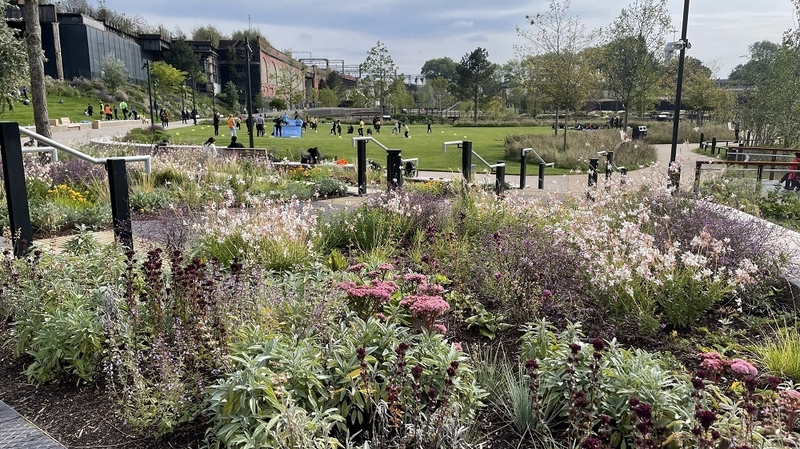
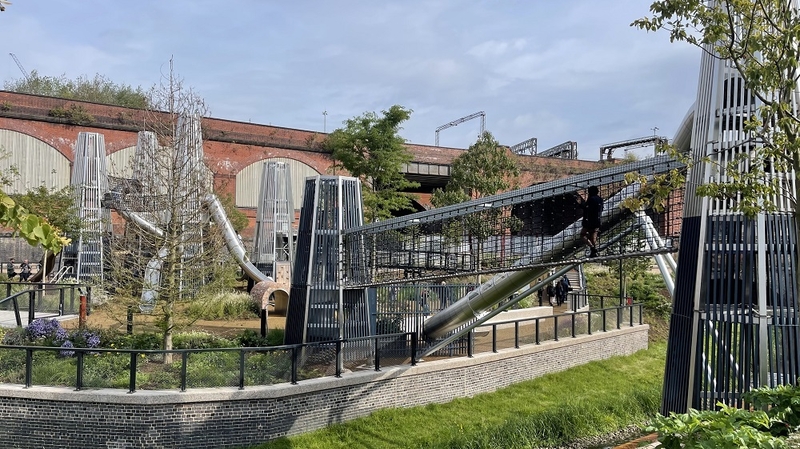
Read next: IN PICTURES: Castlefield Viaduct sky park officially launches
Read again: Exclusive first look at Mayfield Park: looking wonderful, making the city centre better
Get the latest news to your inbox
Get the latest food & drink news and exclusive offers by email by signing up to our mailing list. This is one of the ways that Confidentials remains free to our readers and by signing up you help support our high quality, impartial and knowledgable writers. Thank you!






